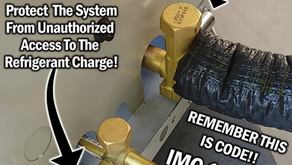The Total Weight Method
- Craig Migliacco

- Apr 15, 2019
- 3 min read
Updated: Jun 18, 2020
This charging method is used for systems that have no refrigerant. It is also used on new systems with a known amount of refrigerant in the outdoor unit. The goal is to break the vacuum with the exact amount of refrigerant needed for the system to function correctly. The amount of refrigerant needed can also be added after breaking the vacuum with refrigerant from the outdoor unit while the system is running.
If a new split system is being installed and the Total Weight Method is used, first view the rating plate of the outdoor unit and read the “factory charge”. This is the amount of refrigerant that comes with the outdoor unit and is locked inside the unit by the service valves.
Next, read the installation literature for the outdoor unit to determine if the factory charge includes a set amount of line set length (such as 15’ or 25’) the evaporator size, and the filter drier size. If the evaporator coil and filter drier match the size listed for the outdoor unit but the line set length is longer than the length included in the factory charge, add the additional refrigerant weight needed. If the actual length of line set is shorter than what is included in the factory charge then recover the amount of refrigerant needed from the system.
Refrigerant weight per foot can be determined using a manufacturer weight chart or the “Refrigerant Weight Per Foot” chart such as this below. Manufacturer charts supersede the chart below.

Example 1: A new R-410A split heat pump system is installed during the winter with 60’ of 7/8” vapor line and 60’ of 3/8” liquid line. The manufacturer’s factory charge of 8 lb 7 oz includes enough refrigerant for 15’ of 7/8” and 15’ of 3/8” line set. How much extra refrigerant needs to be added to the factory charge for an accurate system charge?
Steps to determine the Total Refrigerant Weight:
60’ - 15’ = 45’ of line set
For the 3/8” liquid line, add .54 oz per foot as seen in the “Refrigerant Weight Per Foot” chart.
45’ x .54 = 24.3 oz
For the 7/8” vapor line, add .153 oz per foot as seen in the “Refrigerant Weight Per Foot” chart.
45’ x .153 = 6.89 oz
24.3 + 6.89 = 31.19 oz of additional refrigerant needed
Example 2: A new R-410A split heat pump system is installed during the winter with 40’ of 3/4” vapor line and 40’ of 3/8” liquid line. The manufacturer’s factory charge of 6 lb 5 oz includes enough refrigerant for 15’ of 3/4” and 15’ of 3/8” line set. How much extra refrigerant needs to be added to the factory charge for an accurate system charge?
Steps to determine the Total Refrigerant Weight:
40’- 15’ = 25’ of line set
For the 3/8” liquid line, add .54 oz per foot as seen in the “Refrigerant Weight Per Foot” chart.
25’ x .54 = 13.5 oz
For the 3/4” vapor line, add .114 oz per foot as seen in the “Refrigerant Weight Per Foot” chart.
25’ x .114 = 2.85 oz
13.5 + 2.85 = 16.35 oz of additional refrigerant needed
Example 3: An old R-22 packaged unit had a refrigerant leak and leaked all of the refrigerant out. The leak was fixed and the unit was pressure tested and then vacuumed. The rating plate states a factory charge of 6 lb 5.8 oz. This is the exact amount of refrigerant that the unit needs to have weighed in. The vacuum can be broken with the full amount of refrigerant weighed in as a liquid into the liquid line.
Breaking the vacuum with refrigerant from the bottle is explained in this video- https://youtu.be/RA7BY7dixIg
Check out our book “Refrigerant Charging and Service Procedures for Air Conditioning”.
The full outline is available at https://www.acservicetech.com/the-book
If you have already purchased our book, be sure to tell local HVACR Instructors about our book and what you think of it. We would love to get the book into the hands of the next generation of HVACR Technicians!
Published: 4/15/2019
Author: Craig Migliaccio

About the Author:Craig is the owner of AC Service Tech LLC and the Author of the book “Refrigerant Charging and Service Procedures for Air Conditioning”. Craig is a licensed Teacher of HVACR, Sheet Metal, and Building Maintenance in the State of New Jersey of the USA. He is also an HVACR Contracting Business owner of 15 years and holds an NJ HVACR Master License. Craig creates educational HVACR articles and videos which are posted at https://www.acservicetech.com & https://www.youtube.com/acservicetechchannel









.png)








The core mechanic of the Tigro Club Game cleverly blends elements of chance and skill, ensuring that every session remains unpredictable and engaging.